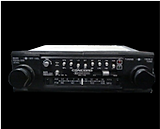
HISTORY
Unparalleled Experience

In 1972, when true high fidelity in an automobile was considered an unrealistic goal, Reus Systems began designing and installing component audio systems establishing audiophile quality within the mobile environment.
Those systems were built utilizing separate woofers, component tweeters and a Crown 150 watt amplifier modified for mobile use. Recalibrated Lear Jet and Delco AM-FM tape players provided extraordinary sound reproduction. One year later, a three channel version of the design, with built in equalization, would influence several auto sound executives, through Reus, to steer the industry in a new direction... leading to the golden era of car audio where most of the creative engineering and design concepts were actually developed.
Our resume of innovations either set or raised the standards of what is now taken for granted in the mobile audio industry. Concepts such as:
Adjustable Equalization - Vehicle Specific Band Pass Enclosures - Close Coupled Woofer Systems - Polymer Transducers - Electrostatic Speakers - Phase and Time Aligned Configurations - Adjustable Azimuths etc. were explored or developed by Reus Systems years before they became applicable to the mobile audio mainstream.
Reus Systems continues to master the new era of high tech car audio. To fully appreciate the depth of the passion and intensity, for what we do, is to understand our connection to the history of mobile audio.
Today, our deep-rooted instincts... evolving through decades of experience... guide the development of audio systems considered a reference standard for performance, while remaining "in sync" with the technology of today's software driven vehicles.
Our own history of design innovations and patents is listed below. The Reus Systems Team hopes that learning more about our past will lead you to join us in our shared future… We love music and want to share The Reus Audio Experience with you.
2016
Continued Innovation
Reus Systems continues to launch newer technologies that are still ahead of the mainstream industry. Targeting solutions which allow Hi-Res music files (MQA, FLAC, WAV etc.) to coexist with lossy audio sources (such as a phone connected via bluetooth) through advanced “D/A” conversion is among many of the concepts we are integrating into mobile audio. They not only refine earlier designs, but allow a much smoother integration of today’s convenient technology when it is judged useful, safe and productive for the end user. Just as when the company was founded, proprietary techniques in design, applied technology and installation techniques continue to set a benchmark which much of the industry will attempt to emulate over the next several years.

































